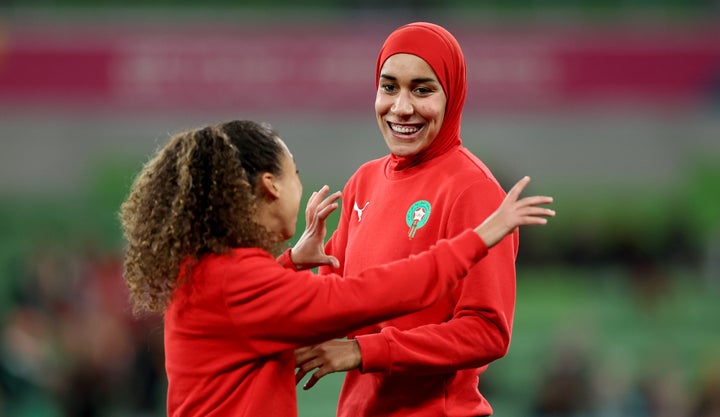
Nouhaila Benzina made history on Monday when she stepped onto the Women’s World Cup pitch to warm up with her football team – while wearing a hijab.
The Moroccan squad ended up facing a pretty brutal defeat at the hands of the two-time World Cup champions Germany, losing 6-0, when playing in Melbourne, Australia.
But, the team had a victory in another sense, because their player Benzina is the first player to ever wear the Muslim head covering at such a senior level of football.
Although she was benched for Morocco’s Group H match against Germany, supporters are hoping her impact will still be felt around the world.
The co-founder of the Muslim Women in Sports Network, Assmaah Helal, said: “Girls will look at Benzina (and think), ‘That could be me.’
“Also the policymakers, the decision-makers, the administrators will say, ‘We need to do more in our country to create these accepting and open and inclusive spaces for women and girls to participate in the game.’”
Benzina plays professional club football for Morocco’s Association Sports of Forces Armed Royal – a team which is the eight-time defending champion in Morocco’s top women’s league. She has played matches in a headscarf before but never at a World Cup.
She hasn’t yet spoken to reporters, but has shared her excitement on social media about wearing the hijab during the World Cup.
Benzina shared a screenshot of a tweet which announced she would be the only hijab-wearing athlete out of the 736 participants of this year’s tournament.
The hijab and sport have a complicated history.
In 2007, a football referee also banned an 11-year-old Canadian girl from wearing a hijab during a match.
Upon hearing of the incident, FIFA, football’s global governing body, then banned head coverings aside from those who exposed the neck, claiming it came down to “health and safety” concerns linked to choking.
Activists then worked to overturn the ban, and in 2012, FIFA announced a two-year trial period for the Asian Football Confederation to allow players to wear head coverings (but not for senior level World Cups).
FIFA’s ban wasn’t completely lifted until 2014, but it’s still a contentious issue in France.
The 2019 Women’s World Cup was held in France, a country which bans the hijab.
And only three weeks ago, a court in France backed the French Football Federation’s decision to ban any footballers who choose to wear the hijab during matches.
Still, Helal said that since FIFA lifted its ban in 2014, she’s spotted more Muslim girls and women playing football.
Morocco is also celebrating its appearance at the Women’s World Cup this year for another reason – it is the first time it has ever competed in the international tournament.
It’s the first Arab or North African country to ever compete in the Women’s World Cup, too.
As Morocco captain Ghizlane Chebbak said on Sunday: “We are honoured to be the first Arab country to take part in the Women’s World Cup, and we feel that we have to shoulder a big responsibility to give a good image, to show the achievements the Moroccan team has made.”
Benzina is expected to play in Morocco’s game against South Korea on Sunday.
